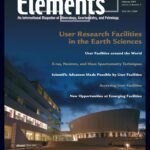
Large Igneous Provinces: Origin And Environmental Consequences, December 2005, Vol. 1, No. 5
June 28, 2024
User Research Facilities In The Earth Sciences, February 2006, Vol. 2, No. 1
June 28, 2024Toxic Metals In The Environment: The Role Of Surfaces, September 2005, Vol. 1, No. 4
$20.00
Metals are prevalent in the environment. They are derived from both natural and anthropogenic sources.
Toxic Metals In The Environment: The Role Of Surfaces
September 2005, Vol. 1, No. 4
Metals are prevalent in the environment. They are derived from both natural and anthropogenic sources. Certain metals are essential for plant growth and for animal and human health. However, at excessive levels they are toxic. Metals undergo an array of processes, including sorption/desorption, precipitation/dissolution, and oxidation/ reduction, with reactive natural surfaces such as clay minerals, metal oxides, humic substances, plant roots, and microbes. These biogeochemical processes control the solubility, mobility, bioavailability, and toxicity of the metals. This issue of Elements explores research frontiers in the areas of metal mobility and reaction mechanisms on natural surfaces. These advances are explored at multiple scales, using state-of-the-art analytical techniques.
Why You’ll Love Elements Magazine:
- Expert Contributors: Articles written by renowned researchers in the field of geoscience.
- Engaging Content: Join a community of readers who are passionate about Elements.
- Exceptional Quality: Each issue is printed on high-quality paper with stunning visuals and detailed illustrations that bring complex scientific concepts to life.
Order your copy of the September 2005 issue of Elements magazine today and learn about the role of surfaces in toxic metals in the environment.
Related products
-
Early Earth, August 2006, Vol. 2, No. 4
$20.00The earliest Earth was a strange inhospitable world, yet transitions occurred culminating in the evolution of life within the first billion years. The preservation of a sparse and ambiguous rock record has encouraged debate.
-
The Nuclear Fuel Cycle – Environmental Aspects, December 2006, Vol. 2, No. 6
$20.00Increasing concerns for the effects of global warming that result from rising greenhouse gas concentrations in the atmosphere have led to a reexamination, even enthusiasm, for nuclear power. Of all the current alternatives to fossil fuels, nuclear fission is the most important source of energy, accounting for 17 percent of the world’s electricity.
-
Water On Mars, June 2006, Vol. 2, No. 3
$20.00During the past several decades, spacecraft data have transformed the planets from astronomical objects into geologic worlds. Mars is the current focus of planetary exploration, and NASA’s objectives for this effort are based on the theme, “follow the water.




